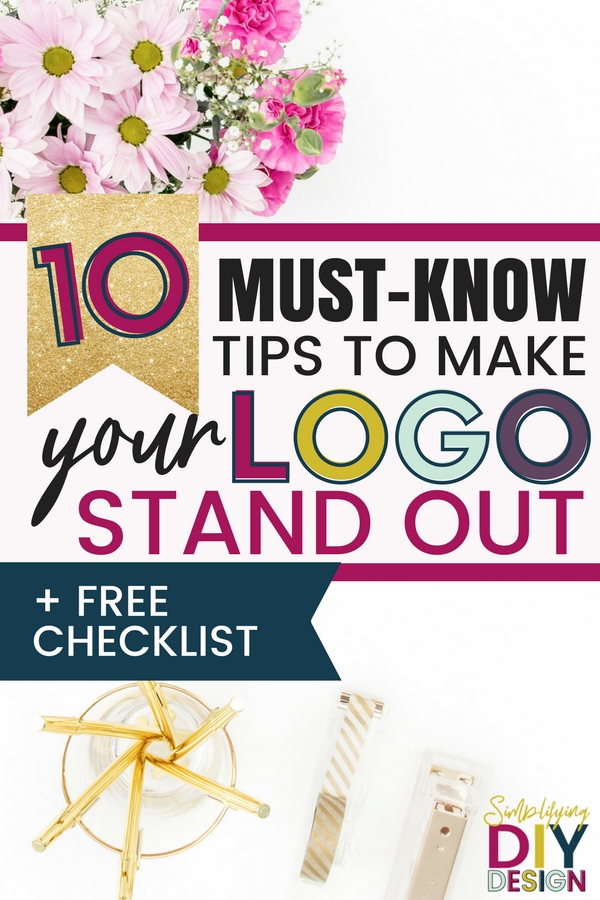In this article, you’ll learn why a logo design is such an important element for your blog, the top characteristics of an effective logo, and my top ten tips for making your logo and brand identity look professional.
This is a guest post by Erika from Erika Lancaster. See the end of the article for more information about Erika and her design business!
When a blogger is just starting out, it can be very difficult to decide what’ll require investing right away, what can wait a bit longer, and what we’ll be attempting to do ourselves.
These decisions will be different for all of us, depending on our personal wants and needs and our initial budget.
As bloggers, we have to be practical and strategic when choosing where to invest our resources, and, in the beginning, paying a designer to create our logo and overall branding may be way too expensive.
However, as creative entrepreneurs starting an online business, we KNOW how important image is and how it’s ESSENTIAL to stand out from our competition.
REMEMBER THIS POST LATER! PIN IT TO YOUR FAVORITE PINTEREST BOARD!⬇

Because I have a background in Graphic Design and Advertising, I’ve been able to fully create my own business identity, website, and marketing strategies.
Nonetheless, it took MONTHS to finally decide my niche and business goals.
I had always been a full-time employee or freelancer designing for someone else’s business, but never my own!
When you’re starting a business, you should NEVER jump into creating your brand’s identity without knowing what exactly it is you’ll be offering and to whom.
It’s imperative that you figure out what sets you apart from your competition and what your personal values are. This will be the foundation for everything else.
Related Post: Read This Before Making a Logo in Canva
Your logo and overall branding should look professional and transmit what your business stands for.
It’ll most likely be the first thing that your clients and/or customers will see when they learn about you.
Table of Contents
WHAT EXACTLY IS A LOGO, AND WHY IS IT SO IMPORTANT?
A logo visually represents your company’s values, beliefs, and goals.
It’s a very important tool that’ll help transmit your brand’s identity throughout all media you produce.
And yes, you ARE a brand, even if you’re only one person!
TYPES OF LOGOS
- Symbol/icon: A small design specifically created for the brand that’s made up of shapes and/or lines and has no letters or words
- Word mark: Typographic arrangement of the company’s name
- Letter mark: Letters arranged in a specific manner (usually the company’s initials or the first letter of its name)
- Combination of typographic elements and a symbol
Which type of logo you create is up to you. It’ll depend on the type of marketing you’re planning for your business and the products and services you offer.
It’s important for you to understand that a logo is just ONE of the many parts that make up a brand’s overall identity.
Related Post: Create a Brand Personality For Your Blog That Just Screams YOU
When we speak of a brand’s overall identity, we’re talking about ALL visual aspects that make up a brand’s look and feel (logo, colors, used fonts, style of photographs/imagery used, etc.).
CHARACTERISTICS OF AN EFFECTIVE LOGO
SIMPLE
Most often, the best logos are simple. They’re legible, clear, and don’t include unnecessary elements. You want to get your message through efficiently and immediately.
RELEVANT
Are your chosen colors, fonts, and symbols appropriate for your niche? Is your logo meaningful, and does it connect with your target audience?
Related Post: Choose the Perfect Color Palette for Your Brand
MEMORABLE
Is there anything you can change or add to your logo so that it can stick out in your potential customer’s minds amongst your competition?
If you can’t think of a specific thing to change in your logo, think of it in terms of your brand’s overall identity.
TIMELESS
Stay away from visual trends to ensure that your logo can stand the test of time.
Refrain from using imagery, fonts, or colors that are specific to any one time period, unless this is specifically what your business is going for (vintage products, etc.). You want your logo to last for a long time!
VERSATILE
Your logo design must work on all types of media you’ll create. It has to be easy to use and legible at its smallest size.
UNIQUE
Is your logo aesthetically pleasing and easily identifiable? Does your play of color, shape, and style set you apart from your competition somehow?
10 LOGO DESIGN TIPS TO MAKE A PROFESSIONAL LOGO
BUILD FROM A SOLID FOUNDATION
Define your ideal audience, your business objectives (both short and long-term), as well as your values. This, in itself, requires a lot of thought and vast research about your competition.
Related Post: How to Achieve Brand Consistency with Your Blog
Before you start designing, write down three words describing your brand’s personality/attitude and keep these in mind throughout the process.
USE REFERENCES BUT NEVER, EVER COPY THEM
Designers use references of all types to get inspired AND to ensure they don’t use an idea that someone else has already put out there.
Create a “reference” folder for yourself and include 3-5 logos that you like.
Pinpoint what it is, exactly, that you like about them. Is it the color, the font style, the placement? Try to apply the points you like in your own new way.
Related Post: FREE Design Generators to Choose Logos, Fonts + Colors
Look at what your competition is doing and think of ways that you can be different from them.
Don’t ever design a logo with a particular style just because it’s what all the popular business owners in your niche seem to be doing!
Try to stay as original as possible to YOU, and don’t allow yourself to be influenced by trends. This will help you attract the audience you want.
MAKE SURE YOUR FONTS COMPLEMENT EACH OTHER
If you use different fonts within your logo, make sure they play well together. Usually, fonts that pair well have a good amount of contrast between them but are also similar in some ways.
For example, a highly stylized and handwritten font could pair up with a very simple and mechanical font.
Or perhaps one word is a thick Sans Serif font, and the other is a thin Serif.
Related Post: 5 Easy Font Design Tips for Bloggers
However, just because two fonts are very different from each other, doesn’t necessarily mean that they will pair up well. There also has to be SOMETHING similar between them, which can be the kerning, proportions, etc.
Pairing fonts can be difficult for someone with an untrained eye. If you’re unsure, stick to fonts from the same family or simply use one.
ENSURE LEGIBILITY, OVER ALL THINGS
Stay away from fonts that are illegible. No matter how beautiful a font may be initially, if it isn’t legible when you use it to type out your company’s name, it won’t work!
Think about the smallest size you’ll be using your logo in. Will you be able to read it? Are there any letters that could be misunderstood by the public?
MAKE SURE SYMBOLS AND IMAGERY ARE SIMPLE AND CLEAN
If you decide to add any symbols or icons to your logo, make them simple. Use, at most, 2-3 different colors and stay away from gradients/effects.
Use grids and geometric shapes to ensure accurate curves and angles when creating your symbols or icons.
This will ensure a clean effect and that it’ll work at its minimum size.
MAKE SURE YOU HAVE THE RIGHT LICENSES FOR YOUR FONTS AND ELEMENTS
Always, ALWAYS, make sure you buy your fonts and any elements you’ll include in your logo (or make them yourself).
Also, make sure that the font and license you buy include the use you’ll be giving to it. The last thing you want is to get in trouble for using something in a way you shouldn’t!
FLIP YOUR LOGO UPSIDE DOWN
This is a trick used by the pros!
Turning your logo upside down will allow your brain to see only shapes instead of specific letters and/or symbols.
It’s a great way to ensure your logo doesn’t contain any imperfections or shapes you may not have intended to create.
DON’T FINISH YOUR LOGO IN ONE SITTING
Designing a logo is a process, and you want to end up with something you’ll use for years to come. Don’t rush!
Take at least a month from the moment you start brainstorming to the moment you finish your brand book (more about this in a moment).
Just because you feel you’ve come up with something nice one day, doesn’t mean you’ll like it next week.
I recommend working on it off and on throughout several weeks. This will ensure that the design is something that you’ll like for a long time.
Also, I highly recommend getting feedback from others before making your final call. Getting other people’s perspectives is extremely valuable.
ABOVE ALL, KEEP THINGS SIMPLE
Remember, your logo will be combined with many other visual elements that’ll make up your overall brand identity (colors, photos, etc.).
Related Post: 10 Blog Design Tips to Look Like a Pro Blogger
You don’t want to over-saturate and overwhelm your audience. Keep it simple, classy, and professional.
CREATE A BRAND BOOK
Brand books are important because they keep a company’s image coherent and consistent throughout all marketing efforts and products sold. They’re especially useful when a business starts growing, as they make sure a brand’s image guidelines are respected and enforced.
A brand book is not difficult to create. Once you have arrived at your logo, and defined the fonts, colors, and photo style you’ll use throughout your website/blog, I highly recommend making one!
To finish up, I want to say that creating your logo and brand identity is totally doable.
Yes, it requires research and effort, and you would definitely benefit from getting feedback from a professional designer. However, you shouldn’t let your lack of resources keep you from getting started!
RESOURCES MENTIONED IN THIS POST:
- Read This Before Making a Logo in Canva
- Create a Brand Personality For Your Blog That Just Screams YOU
- Choose the Perfect Color Palette for Your Brand
- How to Achieve Brand Consistency with Your Blog
- FREE Design Generators to Choose Logos, Fonts + Colors
- 5 Easy Font Design Tips for Bloggers
- 10 Blog Design Tips to Look Like a Pro Blogger
ABOUT THE AUTHOR

Erika loves using traditional art media to create both commercial illustration work and decorative fine art. After having obtained her BA in Graphic Design, Erika gained experience working as both in-house designer for companies as well as advertising agencies. Years later, she left her last full-time design position to become a teaching artist.
Connect with Erika on her blog, Instagram, and YouTube!

Leave a Reply